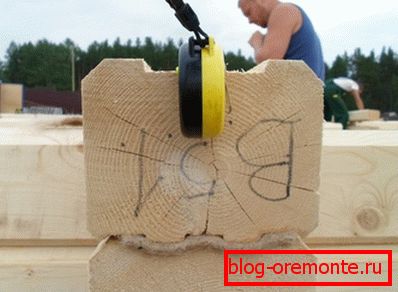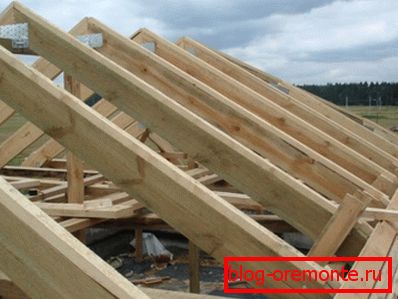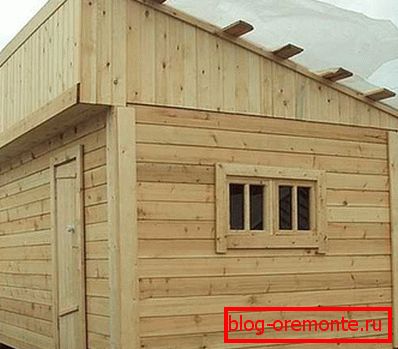How to calculate how much timber should be on the house: the
This article is devoted to solving practical problems of calculating some parameters of the future cottage. How to calculate how much timber you need at home? How to calculate the load on the foundation? These questions inevitably arise during the construction process.
We will try to find answers.

Volume and section
How to calculate the amount of timber at home?
We will have to divide the task into several components:
- Calculation of the number of floor and ceiling beams of beams.
It should be clarified: the floor of the first floor does not necessarily have to be laid on wooden beams. Monolithic slab base - an expensive, but noteworthy solution for unstable soils.
- Calculation of the truss system. Immediately make a reservation: its device can vary greatly depending on the shape of the roof. We will consider one of the simplest options.
- Calculation of the amount of material for external walls.
- Estimation of the amount of timber for internal partitions. Note: most often they are a frame structure; partitions built from profiled timber inside the house are obligatory only if the beams need additional support.
In this order, we move forward.
Beams
Типичная толщина половых и потолочных балок - 100х150 миллиметров при шаге между ними 0,8 - 1 метр. Beams врезаются в венцы в вертикальном положении: в этом случае обеспечивается их максимальная жесткость по отношению к направленной по вектору гравитации нагрузке.

How to calculate the number of beams and their total length?
- The number for each overlap is determined by simply dividing the length of the house by the step between the beams and subtracting one. So, for a house measuring 6x10 meters with a step between the beams of 90 cm, you will need 10 / 0.9 - 1 = 10 beams.
- With a beam length of 6 meters (which coincides with the standard length of the beam), you will need 6 x 10 = 60 linear meters.
However, lumber is sold, as a rule, in cubic meters. How to calculate the cubes of the timber, knowing its section and length? Simply simple: multiply them by first converting all the values into meters. In our case, for a material with a section of 100x150 mm, the volume with a length of 60 meters is equal to 0.1 * 0.15 * 60 = 0.9 m3.
Rafters
How to calculate the timber in cubes, required for the manufacture of truss system? As already mentioned, we consider the simplest solution: a straight gable roof.
The slope of the roof is assumed to be 45 degrees; step rafters - 60 centimeters; their material is a timber with a section of 50x150 millimeters.
Captain Obviousness suggests: the more often the rafters, the smaller their section may be under constant load. By the way, about the load: with an increase in the roof slope, the maximum mass of snow that can accumulate on the roof decreases, but its windage increases. The practical conclusion: in the snowy regions, the roof is better done with a greater bias, in windy - with a smaller one.
In our case, the truss system itself is extremely simple: two truss legs converge over the middle of the house and are fixed by a longitudinal girder — a bar of the same section connecting the tops of the triangles along the longitudinal axis of the house.

So, how to calculate the amount of timber you need for a house to install a roof frame?
- The run along the axis of the house will obviously be ten meters, like the structure itself.
- With a roof slope of 45 degrees, the calculation of the length of truss legs is reduced to the calculation of the length of the legs of an isosceles right triangle with a known hypotenuse (it is equal, we recall, to the diameter of the house - 6 meters). The sum of the squares of the legs is equal to the square of the hypotenuse. Solving a simple equation, we get the length of the truss leg of 4.24 meters. So, each triangle will take 8.5 meters of timber.
- The total number of triangles forming the ridge of the roof is 10 / 0.6 - 1 = 16 (rounded up to the nearest whole value). The total length of the rafters will be 8.5 x 16 = 136 meters. Adding the run, we get 146 meters of beam 50x150.
- How to calculate how much lumber in a cube, we already know. We translate the molding in cubic meters: 146 x 0.05 x 0.15 = 1.095 m3.
In practice, it is better to multiply the calculated amount of timber by about 1.3 times. Why?
Because in the previous calculations we intentionally neglected a number of factors.
- With a length of truss legs of 4.24 meters, we will have a lot of trimming. Yes, they can be used; but when building the rafters will overlap with decreasing length.
- To protect the walls from precipitation, the roof protrudes beyond their limits, forming overhangs. The real length of the truss foot will be slightly more than the calculated value.
- A certain amount of material even in the ideal case will go to trim.
Exterior walls
How to calculate how much lumber you need on a house when it comes to exterior walls?
To clarify: the same simple method of calculation is used to calculate the external walls and load-bearing partitions from the timber. In a separate section, we consider only the manufacture of a frame partition.
Actually, the instruction in this case is reduced to solving a series of simple geometric problems.
- Representing walls, gables and partitions in the form of the simplest geometric shapes, we calculate their area.

- We calculate the area of all openings and subtract it from the previously obtained value.
- Multiplying the area of the walls by their thickness, we obtain the total volume of the timber required for this part of the construction.
- How to calculate how much timber in a cube - we have already figured out. If, when purchasing, it is necessary to convert the cubic capacity to linear meters or to the number of products of a fixed length, you only need to multiply their number in cubic meters by the total volume of the material.
Let's solve a small practical problem. How to calculate a bar for a 6x4 meter bath with a wall height of 2500 millimeters?
We agree that:
- We are building a bath from a bar with a section of 200x200 millimeters.
- Roof - simple shed, with a minimum slope. This is very easy to build with your own hands without complicated calculations of rafters.
- In the bath, one transverse internal partition of solid timber of the same section. In this case, we do not need strength, but the maximum insulation of the steam room from the colder waiting room.
- The size of the entrance door is 200x90, the doors to the steam room are 180x80 cm, the windows in the steam room are 40x30 cm, the two windows in the dressing room are 80x120 cm each.
We proceed to the calculations.
- The total length of the walls and partitions is 6 + 6 + 4 + 4 + 4 = 24 meters.
- Their total area without openings is 24 x 2.5 = 60 m2.
- The openings will reduce this area by (2 x 0.9) + (1.8 x 0.8) + (0.4 x 0.3) + 2 x (0.8 x 1.2) = 1.8 + 1 , 44 + 0.12 + 1.92 = 5.28 m2. There will be 60 - 5.28 = 54.72 m2.
- With a wall thickness of 20 cm, the volume of the walls will be approximately equal to 11 m3 (54.72 x 0.2). Taking into account the margin for pruning (in general, it is equal to 15 percent), we should purchase at least 12.5 cubic meters.
- In Cuba, 25 running meters of a bar of this section (1 / (0.2 * 0.2)). With a length of one product of 6 meters, 12.5 cubes correspond to 12.5 x (25/6) = 52 pieces.

Frame partitions
How to calculate the bar for the house when it comes to a frame partition?
It all depends on its design. A typical solution is a frame made of a bar with a section of 50x50 millimeters in 40 cm increments when plastering and 60 cm for plywood. Frame - vertical; from the bottom and from the top, along the entire length of the partition, there is a harness - a longitudinal beam of the same section.
Useful: the price of drywall is noticeably lower; however, if the walls stacked from a bar are covered with lacquer from the inside, it will look somewhat alien. But the varnished plywood will perfectly fit into the overall concept of a wooden house.
The lack of bar length in this case does not pose any problems: it is easily spliced by simply joining half a tree.
Let's calculate the consumption of a bar for a solid interior partition 5 meters wide and 2.8 meters high.
Covering material - plywood; accordingly, the step between the vertical elements of the frame will be 0.6 meters.
- The upper and lower longitudinal bars will have a total length of 5 + 5 = 10 meters.
- The number of vertical bars with a length of 2.8 meters is 5 / 0.6 - 1 = 8 (rounded up to the whole). Their total length is 2.8 x 8 = 22.4 meters; taking into account the longitudinal bars, we need 22.4 + 10 = 32.4 running meters.
- Do not forget to make an amendment to trimming timber: 32.4 x 1.15 = 37.26 meters.
How to calculate the cubic meter of timber, we still remember:
- In a cube with a cross section of 50x50 mm 1 / (0.05 x 0.05) = 400 linear meters.
- 37.26 running meters will be 37.26 x 0.05 x 0.05 = 0.09315 m3.

Weight
We have learned how to solve a variety of tasks regarding how to calculate a cube of a beam. However, no less important problem escaped our attention - the calculation of the load on the foundation. Hurry to correct this misunderstanding.
Why do you need it
Of course, to calculate the very foundation for a log house.
Since relatively light houses from a timber are usually built on light foundations - screw, columnar and tape, during the construction one has to solve a couple of typical tasks:
- Calculate the basement area with a known mass of the house and the bearing capacity of the soil.
- Calculate the number of screw piles with a known mass of the house and the carrying capacity of one pile.
Reference Values
How to evaluate the mass at home? Weigh it is not easy, is not it?
The task will be simplified for us by the observation made long ago: if the structure of the structure is somewhat balanced (that is, for example, reinforced concrete floors do not lie on walls made of vulture panels), the maximum load on the foundation is approximately twice the total mass of the walls.
The volume of the walls we have learned to calculate. It is clear that for calculating the mass we lack a trifle: reference values of the density of wood of popular species.
In order not to bother the reader to search for reference books, we give them.
Please note: the density of wood is given at a humidity of no more than 18%. The so-called bar of natural moisture can be much more moist and, accordingly, have much greater density.

- Siberian fir - 390 kg / m3.
- Cedar - 420 kg / m3.
- El - 450 kg / m3.
- Pine - 520 kg / m3.
- Kiparis - 600 kg / m3.
- Birch - 650 kg / m3.
- Cherry, larch - 660 kg / m3.
- Beech - 680 kg / m3.
- Oak - 690 kg / m3.
- Ash - 750 kg / m3.
The most popular are cheap spruce and pine; the golden mean between durability and cheapness is cedar. Oak timber is extremely resistant to adverse environmental factors; however, a log house would cost the annual budget of a small African state.
Conclusion
As you can see, the calculations are not particularly difficult. The video in this article contains useful information on this topic, see. Successes in construction!